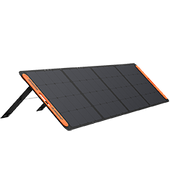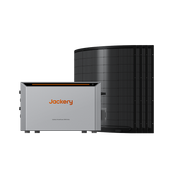In April 2025, a massive blackout swept across Spain and Portugal, leaving millions without electricity and sparking renewed concern over Europe's energy resilience. So, are power outages in Europe common? The short answer is "No—widespread blackouts are generally rare in Europe. However, their frequency and impact vary significantly depending on the country and region.
When such unexpected outages occur, people often look for independent power station solutions. A modern solar power station, for example, can provide far more convenience and reliability for households compared to relying solely on an unstable local grid.
Since localized power outages are an unavoidable reality, the real question is: how can you better prepare when they happen? Read on for more insights and practical advice.
Recent Notable European Blackouts and Other Incidents
1. The 2025 Iberian Peninsula Blackout
On 28 April 2025, at around 12:33 CEST, a massive power outage swept across mainland Spain and Portugal, with ripple effects briefly reaching southern France. In an instant, metros ground to a halt, telecommunications were cut, and businesses, hospitals, and households were plunged into darkness. The disruption lasted for hours, highlighting the fragility of even the most advanced European grids under the wrong circumstances.
The scale of the power outage was unprecedented: an estimated 31 gigawatts of load was disconnected. Tragically, the blackout was not just an inconvenience. It resulted in at least seven deaths in Spain and one in Portugal, linked to accidents such as candle fires and carbon monoxide poisoning from unsafe generator use.
The Cause behind the Incident?
Investigations identified a voltage surge as the initial trigger, which set off a cascade of disconnections across the Iberian grid. This initial disturbance was compounded by multiple structural and operational factors.
In southern Spain, a series of generator trips contributed to frequency oscillations and voltage fluctuations, intensifying the instability. The limited voltage control capabilities of traditional thermal power plants at the time prevented a rapid correction of these fluctuations. Additionally, planning oversights by Red Eléctrica de España meant that the system lacked adequate contingencies to contain such a disturbance.
Authorities quickly ruled out cyberattacks, confirming that the blackout arose from technical and operational deficiencies rather than malicious actions.
Ultimately, the incident highlights that maintaining grid stability in a modern power system requires not only robust infrastructure and advanced technology but also meticulous planning, rapid operational responses, and an optimal mix of power sources. The Iberian blackout serves as a cautionary example of how multiple interacting factors—ranging from generator control limitations to planning gaps—can converge to produce large-scale outages.
2. 2025 Heatwave
During June and July 2025, much of Europe endured one of the most extreme heatwaves on record. Temperatures soared well above 40 °C, stretching across Spain, Italy, France, and Central Europe. The relentless heat had a direct impact on electricity consumption, with peak daily demand rising by up to 14% in Spain alone. The use of air conditioning units surged, placing significant pressure on the power grids of many countries.
Traditional thermal power plants (which still play an important role in grid stability) struggled under the conditions. Many nuclear stations were forced to reduce output because their cooling systems relied on river water, which had become too warm. Some plants also went offline entirely, either due to overheating or maintenance stresses exacerbated by the heat. This created dangerous supply-demand imbalances at precisely the time when demand was surging.
The consequences were felt most visibly in Italy. Cities including Florence, Milan, Rome, and Bergamo experienced repeated electricity power outages, often triggered by two factors: heavy reliance on air conditioning and the failure of aging underground cables, which overheated under the sustained strain. In Florence, the situation became so acute that the Rinascente department store had to be evacuated after a sudden power outage.
The Role of Renewable Energy
Unexpectedly, the heatwave also demonstrated the growing role of renewables. Across the EU, solar power generation surged to record levels, with 45 TWh of electricity produced in June 2025 alone, the highest monthly total ever recorded. Solar farms across Spain, Italy, and Germany pumped unprecedented amounts of clean energy into the grid, easing daytime pressure.
However, the limitations of the system became clear. Solar power peaks in the daytime, but with limited storage capacity, supply dropped sharply in the evenings just as demand remained high. This mismatch drove wholesale power prices above €400–470/MWh in some markets, underscoring the urgent need for large-scale storage solutions, grid flexibility, and investment in backup systems to complement renewable generation.
In short, the 2025 heatwave showed that traditional power plants can struggle in extreme weather, and that solar power has both strengths and limits. It made clear that Europe's grids need to be ready so that bad weather does not lead to dangerous outages or high costs.
3. 2019 UK Blackout
On 9 August 2019, a severe electricity power outage struck the UK. A lightning strike triggered a short circuit on a 400 kV line, causing two major power sources (Little Barford gas plant and Hornsea offshore wind farm) to trip almost simultaneously.
The sudden generation loss caused the grid frequency to drop rapidly, leading to widespread outages affecting nearly a million customers and causing transport chaos.
Restoration began within 15 minutes as backup providers ramped up. Investigations later cited this as a "rare and unusual" event, with near-miss frequency dips already increasing before the blackout.
Causes and Triggers of a Power Outage
Power outages rarely happen without cause; they are usually triggered by a combination of environmental, technical, or human factors. Understanding these underlying issues is essential to knowing when you may need to prepare for a potential electricity power outage.
1. Extreme Weather Events
Severe storms, heatwaves, and heavy snowfall are some of the most common triggers of a power outage. High winds can bring down transmission lines, flooding can damage substations, and heatwaves can overload networks as millions of households rely on air conditioning. For example, the 2025 European heatwave led to multiple electricity power outages in Italy, where cables overheated and demand spiked beyond capacity.
These events are becoming more frequent due to climate change, placing growing pressure on Europe's grids. As a result, authorities must invest in weather-resilient infrastructure and smarter grid management to minimize future disruptions.
2. Infrastructure Failure
Aging infrastructure is another major cause of electricity power outage incidents. Older power lines, transformers, and substations are more vulnerable to mechanical breakdowns. Even modern systems can fail if maintenance is insufficient or if demand exceeds design limits. Once one part of the grid collapses, it can trigger a chain reaction, as seen in the Iberian Peninsula blackout of April 2025.
Deferred investments in modernization often leave weak points in the system, which can quickly escalate into widespread outages. In other words, strengthening the grid with new technology and redundancy is critical to ensuring a reliable electricity supply.
3. Human Error & Accidental Damage
Not all blackouts are caused by nature or machinery; some are caused by human mistakes as well. Errors in grid management, accidental damage during construction work, or delayed responses to equipment malfunctions can escalate into a large-scale power outage. While these are less frequent than weather or infrastructure failures, their impact can be equally disruptive when they occur.
For example, poor coordination between operators can turn a small fault into a nationwide crisis. Training, clear protocols, and real-time monitoring are essential to prevent these errors from spiraling out of control.
What Can You Do to Prepare for a Sudden Power Outage or Achieve Energy Independence?
Power outages can happen suddenly, whether due to storms, heatwaves, or grid failures. While Europe rarely experiences prolonged blackouts, being prepared is essential for safety, comfort, and peace of mind.
Besides creating an emergency supply kit for home, many households are now exploring renewable solutions to achieve greater energy independence.
1. Tips for Preparing for a Power Outage
l Keep an Emergency Supply Kit for Home:
A well-stocked power outage emergency kit should include flashlights, batteries, candles, first-aid supplies, bottled water, and non-perishable food. Keep everything in an accessible location so you can react quickly when the lights go out. Don't forget to refresh and check your kit every few months to ensure supplies haven't expired and the batteries are not drained.
l Charge Essential Devices in Advance:
Whenever severe weather is forecast, make sure that phones, laptops, and portable chargers are fully charged. Communication is vital during a power outage, especially if local services are disrupted.
l Backup Power for Critical Appliances:
Consider a portable generator or solar-powered backup system to keep essentials like refrigerators, medical devices, and heating systems running. This is particularly important for families with children or elderly members. Moreover, test your backup power system regularly so it is reliable when you need it most.
l Plan for Lighting and Heat:
Stock up on LED lanterns or battery-powered lamps, and keep extra blankets available. If you rely on electric heating, a portable generator or alternative fuel source can make a blackout more manageable. Avoid using open flames like candles for long periods, as they can pose fire risks.
l Know Your Local Grid and Safety Steps:
Learn how to manually open garage doors, reset your circuit breaker, and safely store food during a power outage. These simple preparations can save both time and stress. Staying informed through local utility alerts or emergency apps can give you critical updates during a blackout.
2. How to Achieve Energy Independence?
Beyond temporary fixes, households can reduce their reliance on the grid and prepare for future outages with advanced solar-powered solutions. This is where Jackery's solar generators stand out by providing clean, quiet, and reliable backup power.
l Jackery Solar Generator 3000 v2

The Jackery Solar Generator 3000 v2 is a powerhouse designed for both off-grid living and home emergencies. Delivering a 3072 Wh capacity with 3600W output (7200W surge), it can power multiple home appliances simultaneously for an extended period. With eight output ports, including 230V sockets and high-speed USB-C, it is versatile enough for any situation.
Paired with SolarSaga panels, the unit can recharge in as little as 3.5 hours with 1000W input, giving families reliable, renewable power even in prolonged outages. Despite its strength, it is the world's most compact 3 kWh LFP power station (it is 47% smaller and 43% lighter than industry norms). Add ultra-quiet operation (just 27dB in Silent Charging Mode), and it is ideal for study, work, or sleep during an unexpected power outage.
Moreover, the advanced app control allows users to monitor real-time energy usage, schedule charging during off-peak hours, and optimize solar input for maximum efficiency. This helps cut electricity costs while offering reliable backup during a power outage.
l Jackery Solar Generator 2000 Plus

For households needing expandable power, the Jackery Solar Generator 2000 Plus is the best flexible choice. With a capacity ranging from 2 kWh to 12 kWh, it adapts to light emergency backup or heavy-duty, long-term use. Capable of powering devices up to 3000W (6000W surge), it is suitable for larger homes, RVs, or workspaces.
Its fast solar charging technology (it can fully recharge in just 2 hours with six SolarSaga 200W panels) makes it one of the most efficient systems available. Built with LiFePO4 batteries offering a 10-year lifespan and Jackery's ChargeShield variable-speed charging algorithm, the unit combines durability with performance. Whether running heavy appliances or serving as a daily energy-saver, this generator ensures reliable power and long-lasting independence.
Wrapping Up
Across Europe, large-scale power outages remain relatively rare thanks to robust interconnected grids, but recent events, from the 2025 Iberian blackout to the record summer heatwave, show that risks are increasing. Weather extremes, aging infrastructure, and human errors all contribute to vulnerabilities that can disrupt daily life and essential services.
While governments work to make the grid stronger, people can also get ready by having reliable backup power at home. Products like Jackery's solar generators offer clean, quiet, and reliable energy. They help families stay safe and connected during emergencies and take steps toward energy independence.
Reference links:
1. https://ember-energy.org/latest-insights/heat-and-power-impacts-of-the-2025-heatwave-in-europe/
2. https://ember-energy.org/latest-insights/solar-is-eus-biggest-power-source-for-the-first-time-ever/
3. https://www.theguardian.com/business/2019/aug/12/what-are-the-questions-are-raised-by-the-uks-recent-blackout
4. https://www.theguardian.com/business/2019/aug/20/national-grid-blames-lightning-strike-for-blackout-ofgem
5. https://ukerc.ac.uk/news/august-9-investigations/



































































